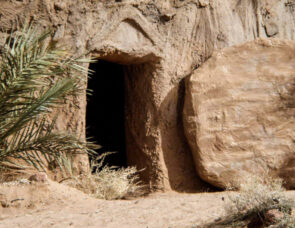Some ideas to illustrate the truths of the resurrection.

On your marks
Here are four simple outlines that use visual aids to tell the story of Easter Day for an all-age congregation or within your children’s group.
Get set
Each of the four ideas makes use of some simple visual aids that you will need to prepare beforehand.
Go!
Idea 1 Empty
- You will need three empty milk bottles.
Time for an awful joke: Outside a castle drawbridge there were three milk bottles: two were full and one was empty. What was the name of the king of the castle?
Answer: Phil-up the Third
Having survived that… say that these three empty (MT) milk bottles can help us to understand the amazing surprise of the first Easter, because there were THREE MTs (i.e. MT MT MT) in that story.
Link the following three MTs to the feelings of those at the cross; then, three days later, to those at the tomb; and finally to their feelings afterwards:
- MT – they had seen the empty cross. Jesus really had died and been taken away.
- MT – they had discovered the empty tomb. Jesus really had risen and was no longer in the grave.
- MT – they had experienced empty lives, but now were filled again with the presence of a Jesus who would never go away again; a new life inside them forever.
Idea 2 Suitcases
You will need three suitcases with the following labels and contents:
- Suitcase 1: Yesterday’s Mistakes – Long till receipt
- Suitcase 2: Today’s Problems – Blank cheque book with signed cheques
- Suitcase 3: Tomorrow’s Unknowns – A heavy weight
Tell the story of a person, say Libby, who has three heavy suitcases – you might like to try to act this out yourself or with help from others.
It seems Libby had to go everywhere with these three burdens. They were part of her life and they couldn’t be put down.
At a crossroads, Libby meets a stranger who offers to help her. Amazingly, this stranger is able to pick up each of the cases easily, one after the other.
The stranger asks Libby what is in the first case. When she opens it, she is surprised to find a long till receipt and not the heavy weight she expected. The stranger explains that this bill has been paid and need no longer be a weight to carry. This is the forgiveness of ‘yesterday’s mistakes’; link this to the ‘it is finished’ cry from the cross, which means that the debt has been paid.
In the second case, Libby finds a blank cheque book but with each cheque already signed. In other words, open access to a heavenly bank account to deal with whatever ‘today’s problems’ may bring; link this to the truth about the power of the cross (e.g. 1 Corinthians 1:18)
With the third case, which is genuinely heavy, the stranger says that he will gladly continue the journey with Libby and help carry the load of ‘tomorrow’s unknowns’; link this to the promise from Jesus that he would be with us always, to the end of time.
As the stranger lifts up his share of the load, Libby notices that he has scars at his wrists.
Idea 3 Continued
Good Friday is a ‘to be continued’ story; the surprise is that Easter Sunday is a ‘THREE ‘B’ continued’ story. How?
- A new ‘B’-ginning (forgiveness and a new start)
- A new ‘B’-coming (the power to be different)
- A new ‘B’-reaving (death no longer has the last word)
Idea 4 Stones
Another visual aid that you can use for Holy Week into Easter Day is ‘stones’. For example:
- Palm Sunday – link to Jesus’ words about the crowd’s Hosannas (in Luke 19:40) and the fact that if they are not allowed to praise, then ‘these stones would start shouting’.
Other stones that take us through Holy Week are:
- The parable of the tenants in the vineyard and the link to the stone that the builders rejected (Luke 20:9 – 19).
- The prophecy that not one stone would be left on another (Luke 21:5 – 6).
- The stone water jar carried by a man, which led to the upper room (Luke 22:7 – 13).
- The stone’s-throw away that Jesus went to pray in Gethsemane (Luke 22: 39 – 41).
- The stone-y place of the Skull, where he was crucified (Luke 23: 33).
- The stone that was rolled away (Luke 24:1 – 3) .
Why not have seven differently sized stones hidden around the church, to be brought up as the talk unfolds?

 Download
Download